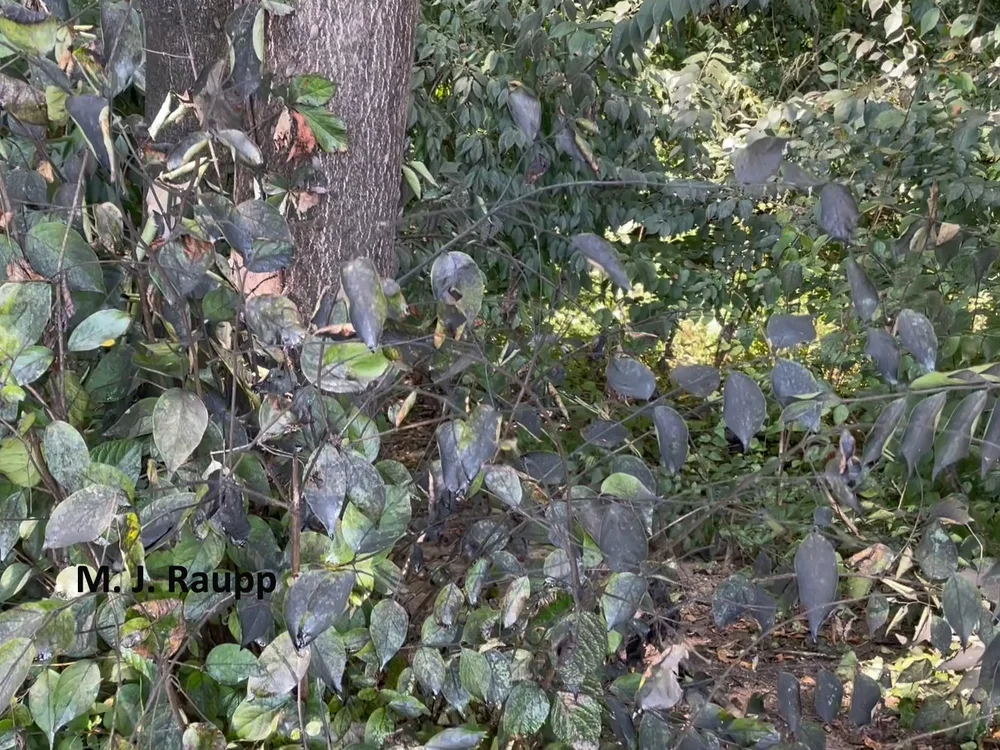Look out DMV, here come dastardly spotted lanternflies – Lycorma delicatula

Is this an albino spotted lanternfly? Maybe not. Learn more below. Photo credit to James Murdock
For the better part of the last moth inquiries about spotted lanternflies have poured into my mailbox. One of the most interesting dealt with the appearance of a remarkable “albino” lanternfly spotted by an inquisitive citizen. Albinism in humans and other animals results when cells responsible for producing melanin, a pigment responsible for color of skin, hair, and eyes, fail to produce enough melanin. While relatively common in humans and other vertebrates, albinism is rare in insects. The pale orange spotted lanternfly that inspired this story is likely a recently molted fourth instar lanternfly nymph. Time out, what the heck does that mean? Lanternflies belong to a clan of insects called the Hemiptera. These insects have sucking mouthparts to sip plant fluids. Their development includes three life stages, eggs, nymphs, and adults. From spotted lanternfly eggs hatch polka-dotted black and white juveniles called first instar nymphs. As they grow from one stage to the next, they shed their exoskeleton just like our more familiar blue crab. Once they shed their old skin, they are almost pure white for a while as their new skin hardens and begins to develop color. The second and third instar nymphs are also black with white spots. However, the last nymphal stage, the fourth instar nymph, is bright red with black patches and white spots when its pigmentation is complete. The picture that inspired this episode is a newly molted fourth instar nymph in the process of turning from pale orange to brilliant red.
Last May in the DMV spotted lanternfly nymphs hatched from eggs. Newly hatched lanternflies are pure white and appear to be albino, but soon they turn jet black and are speckled with white polka dots. For months they have been feeding on leaves and stems of plants in landscapes and gardens. But a few weeks ago, we began to see the beautiful fourth instar nymphs, their scarlet bodies covered with black patches and white spots. Last week reports of adult lanternflies streamed in as lanternflies landed on people and walked across windshields of cars. It won’t be long before hordes of lanternflies gather on trees, shrubs, and vines to feed. So, get ready DMV, here come the lanternflies.
The most frequently asked question in the Bug of the Week mailbag over the past two weeks is why are we seeing so many spotted lanternflies? At least three reasons help us understand why this is the case. First, let’s go back a decade or so to spotted lanternflies’ original detection in Berks County, PA. In the intervening decade, spotted lanternflies have established and are reproducing in more than fifteen states. They have spread more than 600 miles away from ground zero in Berks County. More people are encountering lanternflies simply because they now occupy a much larger geographic area in the US. Here in the DMV we have gone from a few infested counties in Maryland and Virginia in 2018, to more than 60 infested counties. Yes, folks lanternflies are also in the District of Columbia.
Second, as lanternflies spread either by natural means or with assistance from humans, new colonies are established. These new infestations often are founded by an egg mass or two, each with 30 to 60 eggs, that hitched a ride on lawn furniture, a camper, or maybe a metal sculpture. For several years these pioneers might be off the radar, undetected, as was the case with the initial introduction of spotted lanternflies in Pennsylvania. With abundant food sources like the invasive tree of heaven and other delectable plants and low levels of predators, parasites, and pathogens tracking their burgeoning populations, lanternflies can enjoy a period of exponential growth. As satellite colonies merge along the ever-expanding lanternfly front and as populations expand in the generally infested area, more people encounter spotted lanternflies.
Third, size matters. Bigger insects are more commonly noticed than smaller ones. Tiny lanternfly nymphs hatching from an egg are but a few millimeters long. They scuttle about vegetation on the forest floor and low-lying shrubs feeding on more than 100 plant species. However, by July, brilliant red nymphs have molted into tawny coated adults an inch or more in length. Being more than 20 times larger than their youngsters, adults are more readily noticed as they cluster on the trunks of trees or take flight and move about the landscape in search of food, mates, and places to deposit eggs. In reality, due to the high mortality of juveniles which is the hallmark of most insect species, there are far fewer lanternflies now than there were back in May when eggs first hatched. I’ll bet you are finding little or no solace in this.
You think Superman is faster than a speeding bullet? Just watch this lanternfly nymph jet away from the nosy camera. Watch again at one twentieth of normal speed. That’s one speedy bug.
What’s next for spotted lanternfly here in the DMV? Hordes of adult lanternflies and their attendant deluge of honeydew soon will coat vegetation underlying lanternfly infested trees. Honeydew is a substrate for the growth of sooty mold, a non-pathogenic mold that cloaks leaves and stems of plants, reducing the ability of plants to capture the energy of sunlight and conduct photosynthesis. More disturbing will be the arrival of sugar junkies, hordes of wasps and bees intent on enjoying the carbohydrate bounty.

Honeydew excreted by spotted lanternfly forms a substrate for the growth of sooty mold on plants below. Sooty mold reduces photosynthetic capacity of underlying plants. M.J. Raupp
Is there any good news here? As we learned last autumn, scientists at Penn State documented more than 1000 attacks by spiders, mantises, birds, and other predators of spotted lanternflies. Also getting in on the act are naturally occurring soil fungi that have caused at least one lanternfly population to collapse in Pennsylvania. In addition, spotted lanternflies are reported to kill one of their favorite sources of food, invasive tree of heaven. Here’s hoping Mother Nature continues to send help in mitigating the invasion of spotted lanternflies.
For more information on the biology and management of spotted lanternfly click here.
Acknowledgements
Thanks to James Murdock for providing inspiration for this episode. Thanks also to Eloise and Abby Kollins and Paula Shrewsbury for wrangling and spotting spotted lanternflies. Wonderful resources provided by scientists at Penn State University and Cornell University were consulted to prepare this episode. The fascinating article “A pair of native fungal pathogens drives decline of a new invasive herbivore” by Eric H. Clifton, Louela A. Castrillo, Andrii Gryganskyi, and Ann E. Hajek was used as a reference for this episode.
This post appeared first on Bug of the Week




















